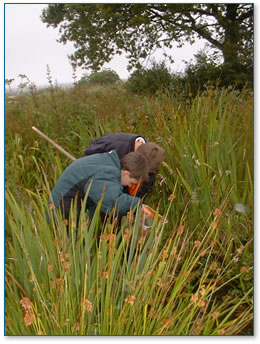schools,
rivers and land Management
 |
|
 |
Pond dipping |
All Cornish schools are different
from each other. One of the reasons for this is that no school stands
on the same piece of land or has the same size, shape or type of
school grounds surrounding it.
Some schools in rural parts of
the county will be fortunate and have large areas of green space
for their pupils to enjoy. Other schools, in city and town areas
may have much smaller school grounds. Whatever the amount of land
a school has it can manage it to support wildlife and help to decrease
pollution entering the water cycle.
For example, there may be areas
in a school’s grounds that appear waterlogged (G1),
and of little use for recreation. Instead of attempting to drain
or dry out these areas to make use of the land, these wet areas
could be encouraged to develop. A waterlogged area might be an ideal
place to allow wetland plants to grow, providing valuable habitat
for birds, insects and mammals (depending upon the size of the area).
In the past, wetland areas were considered poor land and their value
in reducing pollution and reducing flooding was often not recognised.
Consequently, a lot of these areas were drained and built on or
used for agricultural production.
If part of a school’s grounds
go very close to a riverbank, restoring a wetland area could be
very beneficial to the river and fisheries. It is the wetland area
and the plants that live in it that naturally treat dirty or polluted
water, breaking down waste before the water reaches a river or stream
(L06f). They also prevent fast
surface run-off of water and help reduce flooding.
Creating ponds can also be a
great way of providing a habitat for plants and animals (F05).
These examples of land management
may seem quite ambitious, and not very practical if a school does
not have much land. There are some easier ways for schools to manage
their grounds, which will have a positive effect on rivers and the
water cycle.
Don’t concrete and pave
all areas, rainwater cannot soak into tarmac and concrete, they
are what is know as ‘impermeable surfaces’. Grass, trees
and other plants need water to drink, by growing these in the school
grounds rainwater is used where it falls. This means that the amount
of water moving over land at speed after heavy rain, causing erosion
and flooding rivers or streams, is reduced. Trees and plants can
also encourage wildlife to visit or live in the school grounds.
For more ideas and information
on how to start a school grounds project look at ‘Learning
Through Landscapes’ website. This organisation may be able
to offer advice and support for proposed projects.
|

